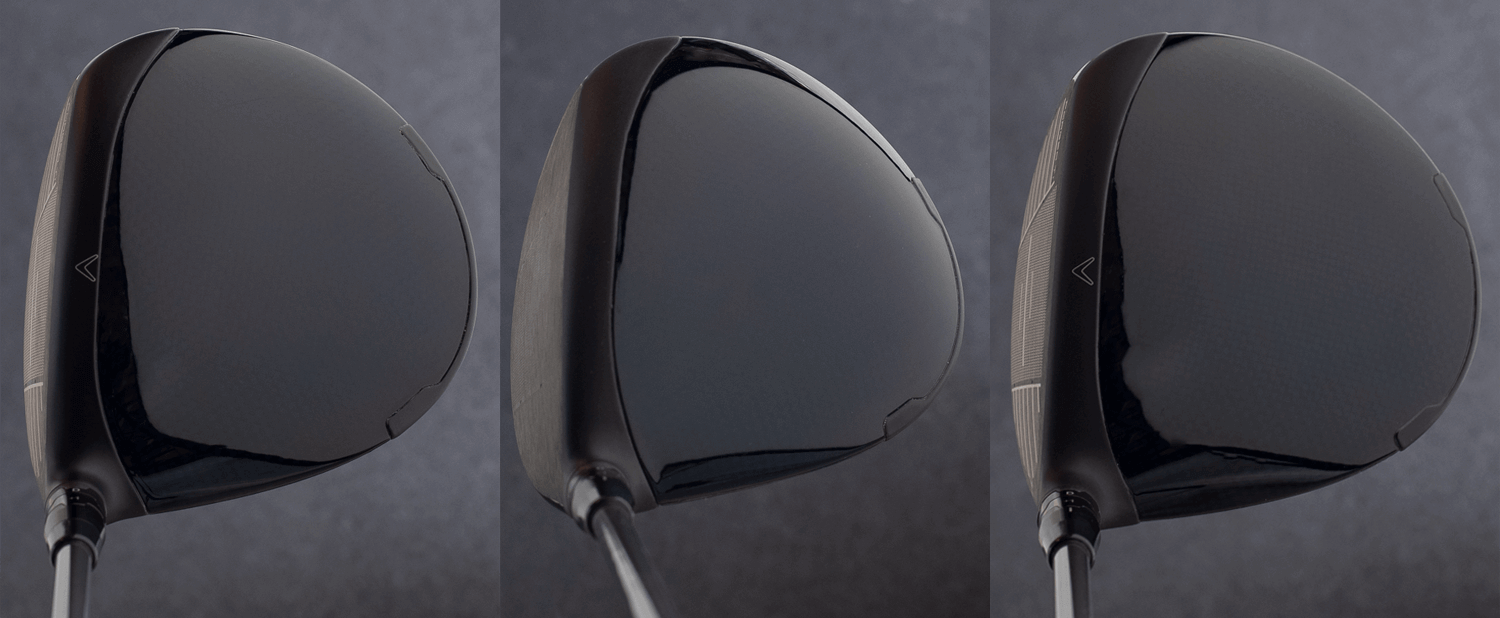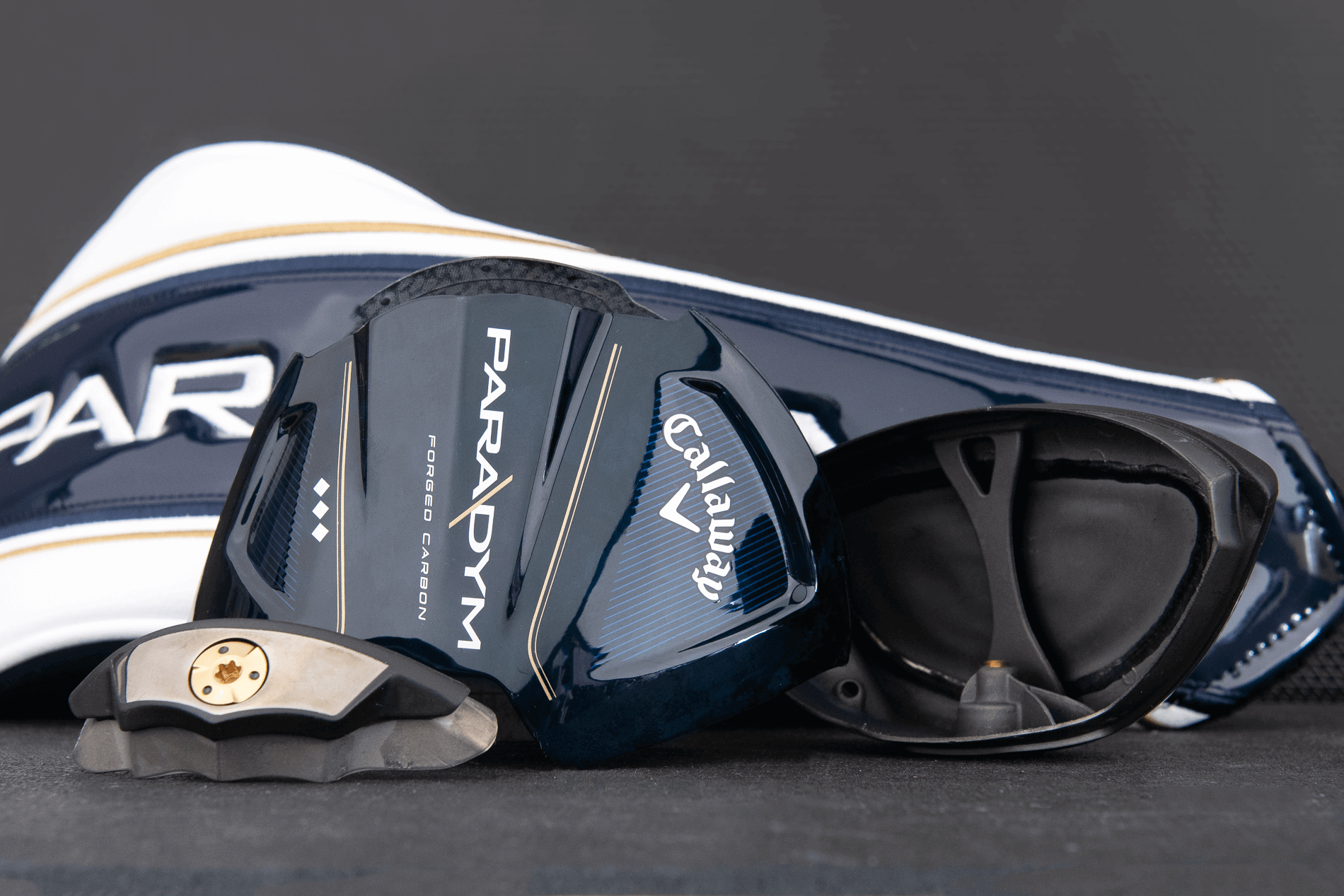- Callaway has announced the Paradym driver lineup.
- The new models feature an innovative 360-degree carbon chassis.
- Callaway says Paradym drivers offer better down-range distance and dispersion.
- Retail price is $600. Availability begins 2/24 (Pre-sale starts 1/13).
The teaser for Callaway’s 2023 launch event billed what we now know is the new Paradym driver as a 360° Shift in Performance. It’s a compelling, perhaps even exciting, proposition—so long as you don’t think too hard about it.
Who sees it?
Shifting paradigms isn’t new to Callaway. It was said that Epic was a paradigm shift. Epic Flash shifted that paradigm, too. So, with the launch of the Paradym driver family, I suppose our original paradigm is now thrice-shifted though, this time around, Callaway has also shifted the generally accepted paradigms of spelling as well.
It does feel a bit like we’re going in circles.
I’m joking, people. We’re having fun. If you’re reading this on launch day, I’m quite literally with Callaway right now. If you never hear from me again, you know what happened.
Toulon did it.
Again, all fun (and games) aside—we’re launching at Topgolf—I’m not alone in thinking Callaway’s flagship Epic franchise has grown stale.
Jailbreak, AI, green paint. Got it.
For sure, the market hasn’t been nearly as critical as I have. Epic, Rogue … doesn’t matter. It still sold but, for me, it was starting to feel like Callaway’s AI machines were caught in an infinite loop. Given my perspective, it’s more than a little refreshing to see something different from Callaway: a completely new line.
You might even say that the fact that it’s January and we’re not talking about Epic or Rogue is, in and of itself, a paradigm shift.
All right. I’m done now.
Sure, the Paradym driver is different but what’s intriguing is that, much like last year’s TaylorMade Stealth, it offers up something we haven’t seen before and brings with it the potential for a real performance advantage.
I said potential, people. Time will do the sorting.
What is it that differentiates the Callaway Paradym driver from everything else on the market? Let’s dig in.
Callaway Paradym Driver – 360° Carbon Chassis
The impetus for the “360-degree shift in performance” teaser is the body or the chassis of the Paradym driver. But, really, there’s an argument to be made that the Paradym, as far as conventional thinking goes, is a chassis-less driver. That all comes down to the construction of the middle portion of Callaway’s new flagship driver.
As we suspected it would when the Great Big Bertha family launched, Callaway is using two different types of carbon fiber to form the body of the Paradym driver.
The crown of the Paradym is made from Triaxial carbon fiber. It’s the same material Callaway has used to form the crown in its last several generations of drivers.
Technically, Triaxial carbon fiber is proprietary to Callaway but it’s not much different from what everybody else uses in their carbon crown. Fundamentally, Triaxial carbon is a sheet material, which is why it works well for crowns and other applications requiring subtle curves, but the material is limited in that it can’t be shaped into more complex geometries.
That’s where the Forged Composite comes in. Forged Composite is basically bits of chopped carbon fiber bonded together. Before Triaxial carbon fiber, Callaway used Forged Composite to form the crowns of its drivers. While I’m sure Callaway doesn’t love the description, it is a bit like particle board in how it’s made.
That’s not to suggest it’s a garbage material or that it doesn’t offer real advantages. Unlike Triaxial carbon, Forged Composite can be molded and shaped into far more complex geometries. With Forged Composite, Callaway can do things it can’t with sheet fiber.
In the case of the Paradym driver, Callaway is using Forged Composite to fully shape what would typically be a titanium chassis.
When the Triaxial and Forged components come together, what you end up with is something akin to a 100-percent carbon-fiber tube.
There are no reinforcing structures, no titanium skeleton—just two pieces of carbon bonded together.
My initial thought was, holy sh*t, Callaway inverted the Stealth.
Why the Callaway Paradym Driver has a 360° Carbon Chassis
A basic rule of golf club design physics is that centrally placed weight is undesirable. Structure in center of clubhead, whether that’s a titanium chassis, support and sound mitigating rib structures and, yeah, even gravity cores represent wasted mass.
These structures aren’t inherently bad. They don’t diminish performance so much as they limit the amount of weight that can be pushed to the perimeter where it can offer real benefit.
To understand what I’m getting at, let’s go back a couple of years.
When COBRA launched RADSPEED, one of the key talking points was the radius of gyration.
We don’t need to get bogged down in the literal definition of the radius of gyration but, adapted to golf club marketing, the concept spoke to the idea that COBRA wanted to take as much weight as it could from the center of the club and push it to the extreme perimeter. In practical terms, we’re talking about increasing the distance from the golf club’s center of gravity to the points where big useful chunks of mass were anchored.
If you can make those big chunks of mass heavier still, well, that’s all the better.
As driver design strategies go, it’s rock solid.
Centrally placed mass does nothing for you but when you can steal what are, in the golf club design world, massive amounts of weight from the center of the club and move it to the extreme front rear and perimeter of the club, you’ve got all sorts of options for lowering spin, increasing MOI (and forgiveness) and, in general terms, doing pretty much anything you want with respect to trajectory and spin.
All of that is why it’s noteworthy that Callaway’s 360-degree carbon chassis is 44 percent lighter than titanium. To be sure, there’s likely some complexity—and, with that, an unspoken weight cost—involved with putting (and holding) all the pieces together but the lack of centrally placed support structures is compelling.
Callaway says the design brings performance with no trade-offs.
Maybe so but if I’ve learned one thing over the years, it’s that there’s always a trade-off.
Nevertheless, Callaway’s hollow carbon tube isn’t something we’ve seen before and, for now anyway, it looks like one of those things that has the potential to change how drivers—or at least Callaway drivers—are made.
Callaway Paradym Drivers – AI and Jailbreak
Part of the paradigm shift, even if doesn’t end up right where we started, certainly lands in a familiar place. Callaway was the first company to talk about using AI (artificial intelligence) to bolster its club design capabilities and it believes it’s still the leader in AI technology and machine learning within the golf industry.
With that, we can expect AI to be a part of every story Callaway tells for the foreseeable future and that means the continuing evolution of AI-driven designs.
As it relates to the Paradym driver, Callaway’s signature Jailbreak technology has evolved from bars to a Speed Frame to what might be described as a more centrally located wishbone structure. If you said it looks like a canoe paddle, I’d accept that.
As objectives and technology evolve, specific Jailbreak optimizations change but the fundamental purpose of the technology remains the same.
Jailbreak Rewind
As your refresher, Jailbreak works to stiffen the connections between the crown and sole. That serves to minimize the energy lost to deflection while still allowing the face to flex. It’s a good bit of the reason Callaway drivers reliably produce some of the highest ball speeds in our Most Wanted tests year after year.
This year’s Jailbreak headline is that it’s 33-percent lighter. That’s a big savings but it’s also true that it’s a savings of weight explicitly added by Jailbreak. While it’s almost certainly a net positive, I think we still have to call it a trade-off.
The shape and placement of the Jailbreak wishbone speaks to the fact that Jailbreak isn’t so much a stand-alone thing as it is part of a larger AI-powered face design system. As Callaway’s engineers feed its machines new parameters, face designs will change. It’s only logical that the whole of the Jailbreak system will change with it.
A New Optimization Paradigm
Seemingly, with every iteration of its driver and underlying AI technologies, Callaway has looked to optimize different performance areas.
With the original Epic, the emphasis was on center-face speed (let’s not talk about mis-hits). With Epic Flash, off-center speed was more of a concern.
As our paradigm shifts again, the performance emphasis of the new Paradym drive is on down-range dispersion and distance. The between-the-lines read is that Callaway hopes to deliver improved accuracy and consistency without trading away speed. A good bit of that comes from the improvements in MOI made possible by the 360-degree carbon cage.

The rest comes from AI-driven tweaks to the topology of the Paradym driver’s face piece. The updated designs leverage face deflection to optimize launch conditions for a given player type. The needs of the Paradym X player are fundamentally different than the needs of the golfer likely to play the Paradym Triple Diamond. It’s why each of the three Paradym models has a unique face design.
Bundled together, the entirely non-legally binding promise of the Paradym driver lineup is consistent launch, consistent spin and, ultimately, tighter shot patterns—all without sacrificing speed.
Paradym Driver – Three Models
With the Paradym driver lineup, Callaway is scaling back the model count from four to three.
The suffix-less Paradym stands in for both the MAX and MAX LS. Admittedly, I’m nervous to see the MAX LS (what we think is the star of Callaway driver lineup) disappear or be part of a 2-for-1 swap. But hey, new year, new paradigm, right?
Callaway expects the standard Paradym will fit the broadest range of golfers which likely explains why it’s the model that includes the 15-gram APW (adjustable perimeter weight).
Golfers should understand that the goal of the weight is to tune, not transform, trajectory. That is to say, there’s not so much wiggle in the weights that swapping positions radically changes the performance of the driver.
Paradym isn’t a true “two models in one” situation though, with about 12 yards of shot-shape difference between the two weight positions, it’s not without versatility. Tuning the Opti-fit hosel to the upright position should get you another three yards or so still.
From a shaping perspective, the standard Paradym isn’t as long from front to back as the Rogue. The reduced elongation is one of the benefits of the 360-degree Carbon Chassis as it allows Callaway to increase MOI without having to stretch the body to the extremes of what the USGA allows.
Now is probably a good time to mention that the standard Paradym is the most forgiving of the three models.
The Callaway Paradym driver is available in nine, 10.5 and 12 degrees.
Callaway Paradym X Driver
Overlapping a bit with the standard Paradym, the Paradym X could replace either the Rogue Max or the Rogue Draw, depending on the player.
Callaway ditched the “Draw” moniker after feedback from consumers and fitters suggested that, while plenty of golfers benefit from draw-biased drivers, not everyone is keen to buy a club with “Draw” explicitly in the name.
As you’d expect, given that placement, it has the largest head profile of the three. It also has more draw-bias baked in and, loft for loft, it’s going to launch higher.
Unlike the other two Paradym models, the Paradym X doesn’t offer any movable weights and it’s worth clarifying that, while the X is designed for golfers who need a certain type of forgiveness (consistently higher launch, an anti-slice bias), it’s less forgiving than the standard model with respect to MOI.
The Callaway Paradym X is available in nine, 10.5 and 12 degrees.
Callaway Paradym Triple Diamond Driver
Once upon a time, the Triple Diamond marking signified a low-spin, Tour-only offering. With the Paradym Triple Diamond driver, that’s roughly half true.
The Paradym Triple Diamond is still the lowest-spin offering in the lineup but, according to Callaway, this Triple Diamond is identical to the one that will be played on the PGA TOUR. It’s not some watered-down consumer-grade Triple Diamond-Light (is that just a Double Diamond?) version.
Having said that, excluding left-handed versions, there are currently three Paradym Triple Diamond variants (including a Triple Diamond S) and three standard Paradym driver variants on the USGA’s conforming clubs list, so I think it’s fairly safe to assume there will still be some tour-only options floating around.
As all of that suggests, the Paradym Triple Diamond (am I supposed to use words or emojis here?) is the most compact of the three Paradym drivers. While the other two feature varying degrees of draw bias, the Triple Diamond is designed to promote a bias-free neutral trajectory.
It ships with the heavier (14-gram) weight in the front where the expected trajectory is flatter with lower spin. Swapping the 14-gram weight to the back and bringing the two-gram weight to the front will raise the trajectory and increase spin by about 250 rpm while giving the driver a little bit of an MOI bump.
The Callaway Paradym Triple Diamond is available in eight, nine, 9 and 10.5 degrees.
Callaway Paradym Drivers – Tour Player Gains
While it’s too soon to say how Paradym will perform on Tour over the course of a season, here’s the quick rundown of the gains realized by Callaway staffers during testing.
- John Rahm picked up four mph of ball speed and increased total distance by six yards.
- Xander Schauffele increased ball speed by four mph while gaining four yards of distance.
- Rose Zhang gained three mph of ball speed and seven yards of distance.
The ball speed numbers are intriguing if only for the fact that the bulk of Callaway’s talking points are around consistency and tighter dispersion. If you could get that AND a speed boost, wouldn’t that be something?
Callaway Paradym Driver – Initial Concerns
Painting with broad strokes, the Paradym is the most compelling (and exciting) driver lineup from Callaway in several years; maybe since the original Epic. That said, there are a couple of things we’ll be looking at once they hit retail and start finding their way into golfers’ hands.
Durability – As discussed, the new body construction lacks the traditional supports. As much as Callaway optimized distance and dispersion, bad shots are going to happen and when they do, some golfers will slam their drivers in disgust (FYI: I’m more of a thrower than a slammer).
I’m sure the Paradym has been tested. Everybody tests everything but we also know the real world sometimes gives you more than you planned for.
My hunch is that Callaway has protected against such things by over-engineering Version 1 of its 100-percent carbon body to protect against exactly those type of things. Assuming everything holds up, future iterations will likely be more aggressive with increased weight savings.
Sound/Feel – Callaway has been hit-or-miss on sound in recent years. It’s also true that ideal (even good) sound is often a trade-off for performance or some other functionality. You can find examples every year in every category. Recent examples that spring to mind are PING drivers and the notorious COBRA F6+ where the innovative carbon track had dire sound consequences.
I bring it up because the most common way to mitigate the unpleasant frequencies and vibrations that we interpret as “bad sound” is to use sound ribs, often in the center of the club. Carbon fiber typically presents a sound challenge and, with no titanium to help mitigate, I’m curious to see how the sound of the Paradym lineup is received.
It’s Blue – Not so much a concern, but rather a simple acknowledgment that the crown of the Callaway Paradym driver (all three flavors) is blue – or maybe dark teal. In certain lighting conditions, it’s really blue and definitely more blue than our address photos make it appear. Frankly, that shouldn’t be an issue but I’m also positive that not everyone is going to love it and some will likely decide not to buy because of it. Going with blue is a bold, though risky, play.
For what it’s worth: In early testing, nobody on the MyGolfSpy staff had anything negative to say about it.
Stock Shafts
Callaway is offering four stock shafts with the Paradym driver lineup.
- The Aldila Ascent PL Blue is the lightweight option for golfers seeking higher launch (and, yes, more spin).
- The Project X HZRDUS Silver is your middle-of-the-road mid-launch, mid-spin option.
- The Project X HZRDUS Black is your mid/low-launch and -spin option.
- The Diamana Kai’Li White should prove to be the lowest-launching and -spinning option for most golfers.
My take on the lineup? There’s nothing particularly offensive here nor is there anything particularly exciting. For the most part, that’s all you should reasonably expect from a stock shaft lineup.
The stock grip is a Golf Pride Tour Velvet.

Callaway Paradym Availability and Pricing
Pre-sale for the Callaway Paradym driver lineup begins 1/13. Full retail availability starts on 2/24.
Retail price for all three models is $599.99.
For more information, visit Callawaygolf.com.
































edward williams
1 year ago
What are the head weights for each head?